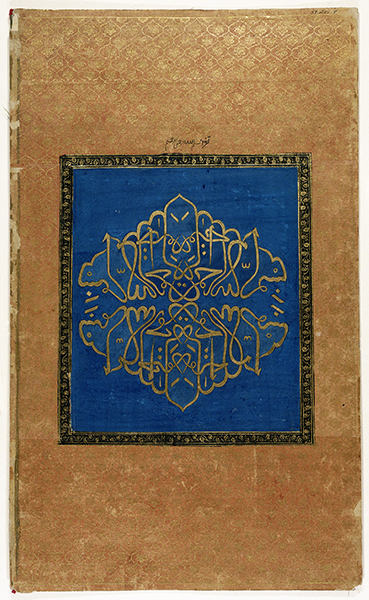Muthanna: Calligraphic Mirror Writing
I’m celebrating two national days today with this beautiful calligraphy—National Backward Day and National Inspire your Heart with Art Day. What better way than with an image of calligraphic mirror writing?
 |
| India, The Bismillah, 1875–1900. Opaque watercolor and gold leaf on paper, page: 19 5/8" x 11 13/16" (49.8 x 30 cm). © 2022 Brooklyn Museum. (BMA-5277) |
During the later Mughal Period in India (1526–1700s), albums containing samples of painting and calligraphy were increasingly more common than illustrated books. The paintings and calligraphy were mounted onto pages with decorative borders and bound in painted and gilt leather bindings. This later example of the Bismillah probably came from such an album.
The Arabic phrase Bismillah al-Rahman al-Rahim ("In the name of God, the Merciful, the Compassionate") opens all but one chapter of the Qur’an. To repeat the Bismillah is to repeat the word of God; to do so in beautiful script is to glorify the word of God. In this unusual calligraphic composition, the phrase is written four times: right side up, upside down, and in the reverse of each of these.
Calligraphic mirror-writing, called muthanna in Arabic, was a popular form of art in Turkey, Iran, and India during the 1700s and 1800s. Scholars believe that the style dates back as far as the 600s to the 800s CE, and examples of mirror writing have been found in Greek and Latin. This suggests that it was a cross-cultural development.
Art forms often considered “decorative” in the West—book illustration, glass, metal, and textiles—are the major forms of Islamic art. Writing is particularly venerated as it is the means of revealing God’s word. Its primacy as a decorative motif in architecture—calligraphy—is carried into all art forms.
The prominence of writing, which is emphasized throughout the Qur'an, led to the importance of calligraphy as an art form. Islamic book arts (calligraphy, illustration, and binding) matured in the Islamic Golden Age, which coincided with the ‘Abbasid Dynasty (750–1258). In earlier periods of Islamic history, the Qur'an seems to have been the most common book to be produced and decorated.
During the Islamic Golden Age, a variety of books were created. This is largely due to the fact that paper became more available, replacing parchment as the major medium for writing and illustration. The Qur'an continued to be produced, along with scientific works, romances, histories, and epic and lyric poetry compilations.
The lack of interest in panel painting in Islamic lands was due to Qur'anic restrictions against figurative depictions in art. Books became a major form of artistic expression. Calligraphers and illuminators were highly respected; their workshops were often sponsored by princes or courts. Paper was cheaper than parchment, so it meant that more people were able to buy books. Compared to Western Europe during the same period, the rate of literacy in Muslim countries was very high.
Correlations to Davis programs: Explorations in Art 2E, Grade 5: 5.2, 5.3; A Personal Journey 2E: 4.2; Exploring Visual Design 4E: Chapter 1; The Visual Experience 4E: 4.1


Comments